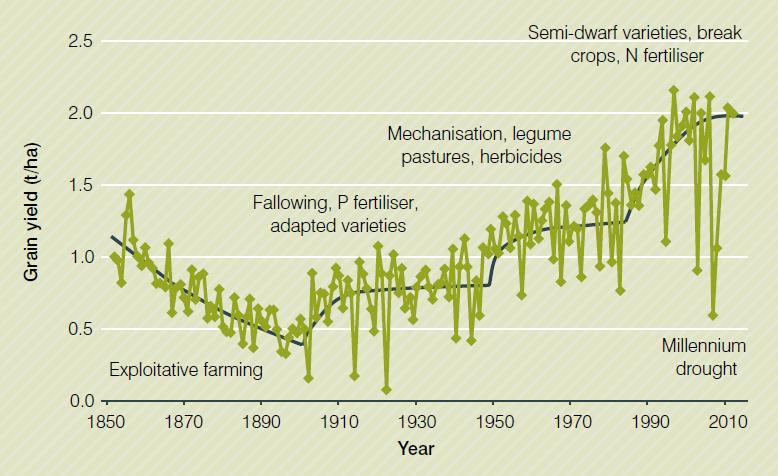Drivers of profit and success - use of technology on the farm
Author: Ben Boughton (Gilroy Farms) | Date: 01 Sep 2015
Take home messages
- Satellite is the best bang for your buck for whole farm overview, but can be unreliable (cloud!).
- Drones are a leap forward, but drain time and are expensive.
Key features of our operations
- Three metre controlled traffic farming (CTF), no-till, real time kinematic (RTK) global positioning system (GPS), disc planters.
- Wheat (Suntop, Lancer), barley (Commander), chickpeas (PBAHatTrick), sorghum (HS102,114).
- Remote monitoring – weather station/camera – new – Our closest official weather station was previously 40km away. Now we can monitor remotely and have an automated weather log.
- Variable rate fertiliser – new – for the last two years we have been trialling variable rate pre-plant urea.
- Satellite imagery – new – satellite imagery access gives a new perspective to management. We see things that we often didn’t know were there and are able to measure the extent of growth due to a multitude of factors such as water-logging, planter/sprayer mishaps, disease, natural soil variation, varieties etc.
Success is subjective
What is success? Everyone has a different view of success. For our family it probably comes down to these few factors: profit, growth, enjoyment, and keeping the yield curve in an upwards direction which relates to the first three.
Technology fits in nicely to those success parameters. But, it is by no means the only contributor to success.

Figure 1: Are we in a successful period? Average farm yield of wheat in Australia (Fischer, Byerlee, & Edmeades, 2014).
Things that works for us overall:
- Timeliness.
- Stick to rotation cycle: wheat-barley-sorghum-chickpeas (preferred), or wheat-barley-chickpeas-wheat.
- Best practice is usually best.
- Attention to detail where required.
- Treat every weed as a resistance risk.
- Time off.
- Learning.
- Cost-effective experimentation: looking at new technology without spending too much.
Technology opportunity of drones
- Recommended reading:
- Informa Economics: The ROI Calculator, Quantifying Returns from Drone as a Service® in Precision Agriculture Systems Click here for report
- The Potential for UAVs in the grains industry (Ben's Nuffield report)
- $4-$13.50/acre ($9.50-$34/ha).
- Uses: detect changes and identify anomalies across a field.
- Applications: crop scouting, 3D terrain mapping, irrigation management, crop insurance, crop production forecasting, and pesticide spraying.
Technology opportunity of satellite imagery
- Been around for a long time, prices falling rapidly and it is getting better.
- Varies from cents to several dollars per hectare depending on resolution.
- Can be less reliable than drones due to the dependency on the cloud, but can be more reliable in regards to quality control.
- Medium resolution imagery excellent value and ideal for capturing crop variability throughout season.
- Calculate poor performing areas.
- Check out paddock history before buying that new block.
What works for us: technology
- Satellite is best bang for buck for whole farm overview, but can be unreliable (cloud!).
- We look closely at every paddock after each satellite cycle and target crop inspections accordingly.
- Drones are a leap forward, but drain time and are expensive.
- Data is excellent if done right, but suit more targeted applications.
- We have not collected drone data yet in 2015.
- Can see an excellent fit for cotton or horticulture at the moment, and grains when prices fall and processing is more robust.
Contact details
Ben Boughton
0428 548 688
bboughton@gmail.com
Was this page helpful?
YOUR FEEDBACK
To protect your privacy, please do not include contact information in your feedback. If you would like
a response, please contact us.
